Replay Media Splitter is a really easy program to extract or remove portions of audio and video files, as well as merge shorter clips. With a visual display, and an easy way to include and exclude segments of your media, you'll be slicing and dicing video and audio files in minutes.

Replay Media Splitter supports all popular video and audio formats including:
If you discover that your media file is not in one of supported formats, we recommend using use a conversion tool like Replay Converter.
Here's a quick summary of the editing process:
Hint: Position the mouse arrow over any button to see a hint about what the button does.
Splitting is the process of dividing your video files into parts. For example, you can cut out a piece of video with undesired scenes (such as ads or commercials). The splitting process leaves source files intact saving the result in the destination file folder. Here are the basic steps for editing audio and video files:
You'll need to load a file to edit first. Click the Add Files to the Media Library button, then pick a file from your PC. The Media Library can contain more than one file for a project but they need to be in the same file format.
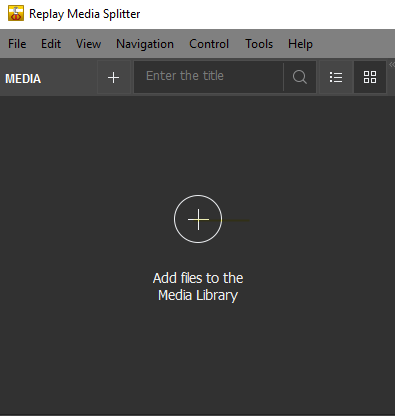
You can now drag files for editing from the Media Library to the timeline. To place several files on the flexible timeline, place new files at the end of each existing file on the timeline.

Next, you'll use the Splitting Controls to mark the fragments of your file that you’ll be removing from the final video or audio file. Here's a rundown of the splitting controls and their functions:

A marker is a constituent part of an interval. The interval consists of two markers: start and end. It is set in the current cursor position. When the mouse pointer is in the area of the timeline the marker is set in the mouse pointer position.
The blue color means that the marker is selected. If marker is not selected it has the white color.
Operations such as deleting and positioning are applied to selected markers only.


An interval is a part of a movie (or audio) file limited by two markers that is to be removed or kept in the final movie, e.g. the commercial block you need to be cut out.
The cut out interval is usually highlighted with the red color.
You can see a sample keep and cut out intervals in the selected and not selected state below.
In case of some marker's time position corrections, you could deploy the collapsed interval by double clicking on it.
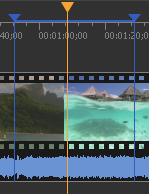
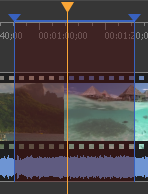

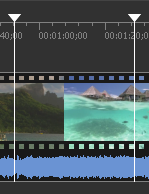
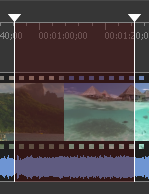

| Button | Function | Keyboard Shortcut |
|---|---|---|
| Add Beginning Marker: Adds a new start marker to the current slider cursor position. | M | |
| Add End Marker: Adds a new end marker to the current slider cursor position | N | |
| Set Audio Silence: Adds audio silence to the selected fragment. | 15 | |
| Save: Starts the trimming or batch processing (if there are any tasks in the batch queue). | CTL+T | |
| Output Folder: Click to browse to and set the Output Folder | 21 | |
| Left Marker Cursor Time Position: You can edit this value manually. | 24 | |
| Right Marker Cursor Time Position: You can edit this value manually. | 27 | |
| Zoom: Increase or decrease the slider timeline resolution to make editing markers easier to see. | NumPad (+/-) | |
| Storyboard On/Off: Display or hide the storyboard | 34 | |
| Audio Waveform On/Off: Display or hide the audio waveform. | 37 | |
 |
Cut/Keep: Choose your mode of editing. When set to Cut, the selections will me marked for removing. When set to Keep, the selections will be kept and the unselected portions will be discarded. | 40 |
Now that you know how to do basic editing, it's time to learn how to move the selector to important parts of the audio or video file. Replay Media Splitter has a lot of really handy ways to get to the important parts of any media file. Here's everything you need to know about navigating:

Navigation controls are designed for navigation through an open source media file. Using these controls, you can start and stop playback, pause it or search for the necessary position forward and backward. Also, the current position and total duration are displayed.
| Button | Function | Keyboard Shortcut |
|---|---|---|
| Previous K Frame | Left Arrow | |
| Next K Frame | Right Arrow | |
| Play/Pause | ||
| Pause | ||
| Previous Frame | CTL + Left Arrow | |
| Next Frame | CTL + Right Arrow | |
| Slider Cursor Time Position. You can edit this value manually. | ||
| Total File Length |
The Navigation menu lets you move forward and back in various handy increments, and also gives you a quick reference to the various keyboard shortcuts:
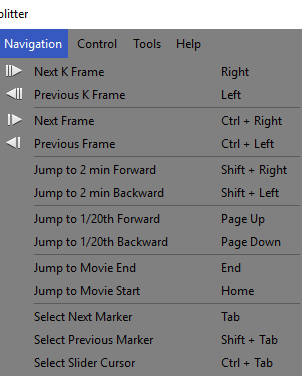
The left and right arrows move to the previous or next K-Frame. K-Frames are significant points of transition in a video file - usually the start of a new scene or camera shot. Moving between K-Frames is an efficient way to locate important segments quickly.
Here's the technical side of K-Frames. Video files are a series of images. When video files are compressed, rather than compressing each image in the video, some images are calculated as a difference from the previous image. If there are several seconds with little movement, for example, the video compressor just saves the differences between each frame instead of saving each image. This leads to efficient compression.
However, there are times when two adjacent frames are very different, such as a new camera shot. When that’s the case, an entirely new starting frame - a new K-Frame - is brought into the compression process. After that frames are again calculated as differences from the K-Frame.
Replay Media Splitter supports navigations between K-Frames, which greatly speeds up the editing process.
Joining is the process of combining multiple parts or fragments of video/audio into a single file. Joining does not involve re-encoding so it does not affect the output audio/video quality.
Use the Join Manager to join files with equal parameters. Specifically width/height of the frame and file type.
To join files, click Join Manager from the Tools menu, then Show Join Manager:
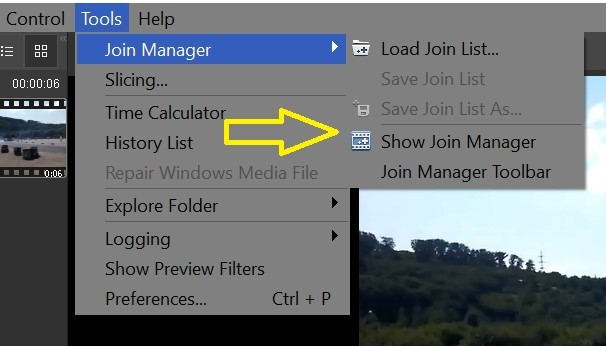
The Join Manager will open:
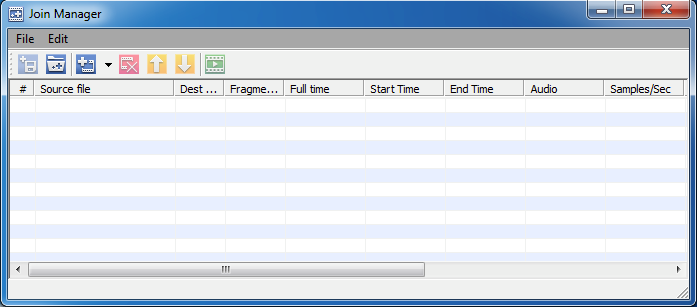
Note: MP3 files will take on the MP3 tags of the last file in the list. If you would like your MP3 tags to be something different, you should edit tags of the joined file manually.
Replay Media Splitter is designed to split media files without losing audio/video synchronization. However, some media files lose synchronization after splitting. To avoid losing sync, you can try to do the following:
Replay Media Splitter was developed by Solveig Multimedia © Copyright All rights Reserved